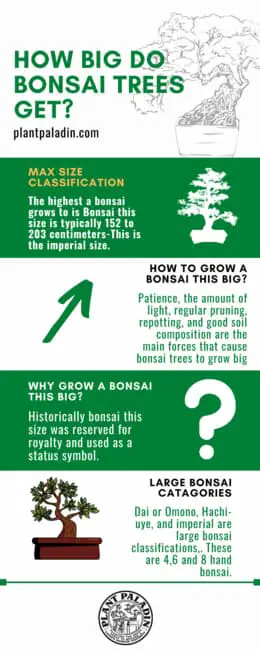This website is supported by its readers. If you click one of my links I may earn a commission. I am also a participant in the Amazon affiliates program and I will also earn a commission from qualified purchases.
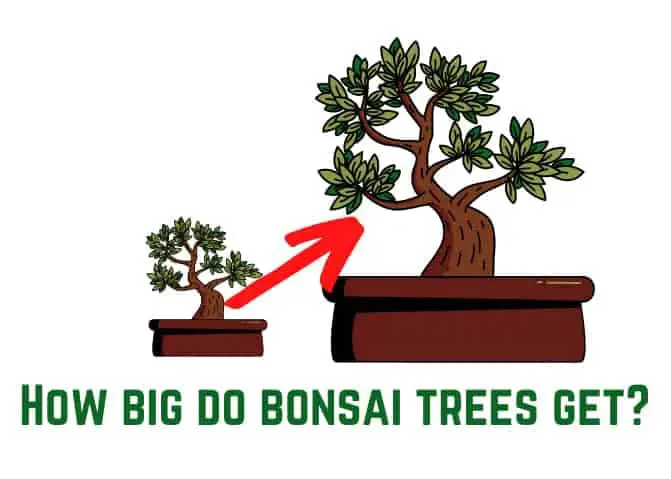
As this year’s growing season comes to an end, I’m impressed by how much my Chinese Elm has grown. They have packed on a few inches in size this year alone. That got me thinking if I were to leave a bonsai to grow uninterrupted, how big would it get? How big do bonsai trees get?
The largest bonsai trees can grow between 152 to 203 Centimeters or 60 to 80 inches. This is classified as an imperial-sized bonsai or an 8-hand bonsai. If bonsai grows larger than this, it no longer falls into a bonsai size classification.
Achieving a bonsai this size, however, will take decades of patience/maintenance, and so this has only been the luxury of Japanese or Chinese emperors historically.
To find out more about the different size classifications of bonsai, I would recommend having a look at my pot on bonsai size classification here.
Just a quick heads up, over the past three years of running Plantpaladin, hundreds of people have asked for product recommendations. As such, You can find my favorite indoor bonsai tree here (link takes you to Bonsaiboy), my favorite outdoor bonsai tree (link takes you to Bonsaiboy), or have a look at all the products I recommend here.
How big do bonsai trees get?
One of the things I loved about bonsai trees is their size. I mean what other gardening hobby can you do that isn’t that messy and is contained to one pot.
That being said, bonsai is one of those hobbies where it is up to the owners how they want their trees to look and so whilst a lot of bonsai are typically small or medium-sized, it is not uncommon for them to be large-sized bonsai.
So how big do bonsai trees get?
Well luckily after scouring the web, calling up a few professionals, visiting my local bonsai and garden centers, attempting to grow large bonsai myself over the past year, and most importantly poling plant paladin readers we can come up with the following:
- The largest bonsai trees can grow is to the imperial-sized bonsai classification.
- This is also known as an eight-handed bonsai as it will take eight hands to lift.
- Bonsai this size are typically 152 to 203 centimeters.
- In inches, this is between 60 to 80 inches
- That being said most imperial-sized bonsai fall into the 170cm category or 67 inches – which funnily enough is the average height of a man globally.
- Bonsai that exceed these height parameters will typically not be allowed in competition and will fall under the category of a small tree.
- Historically bonsai this size were reserved for royalty and used as a status symbol, and so emperors of the far east used to keep imperial sized bonsai
- Growing a bonsai this big often takes years if not decades of patience, hard work, and pruning.
- Other large bonsai categories are Dai or Omono and Hachi-uye, all of which range from 30 to 60 inches or 76 to 152 centimeters.
- Most bonsai globally however fall into the average size of a bonsai of 25 to 46 centimeters or 10 to 18 inches
- This is also known as Katade-mochi or two-hand bonsai.
Now I appreciate this can be a little bit confusing so to help break down the different sizes bonsai can be as well as the natural size classifications of bonsai, check out the table below:
| Classification | Size inches | Size Centimeters | Hand size | General size |
| Keshitsubo | 1 to 3 inches | 3 to 8 centimeters | Fingertip | Tiny |
| Shito | 2 to 4 inches | 5 to 10 centimeters | One-hand | Tiny |
| Mame | 2 to 6 inches | 5 to 15 centimeters | One-hand | Small |
| Chohin | 5 to 8 inches | 13 to 20 centimeters | One-hand | Small |
| Kumono | 6 to 10 inches | 15 to 25 centimeters | One-hand | Small |
| Katade-mochi | 10 to 18 inches | 25 to 46 centimeters | Two-hand | Medium |
| Chiu or Chumono | 16 to 36 inches | 41 to 91 centimeters | Two-hand | Medium |
| Dai or Omono | 30 to 48 inches | 76 to 122 centimeters | Four-hand | Large |
| Hachi-uye | 40 to 60 inches | 102 to 152 centimeters | Six-hand | Large |
| Imperial | 60 to 80 inches | 152 to 203 centimeters | Eight-hand | Large |
What makes a bonsai tree grow big?
Patience, the amount of light, regular pruning, repotting, and good soil composition are the main forces that cause bonsai trees to grow big. Avoiding fungal diseases and pest infestations are also imperative to successfully grow a large bonsai.
Let’s explore each of these factors below:
Patience
Easily the biggest factor in growing a larger imperial-sized bonsai is the amount of patience you will need.
It can take around 10-15 years for a bonsai tree to grow into a medium or regular-sized bonsai with a larger 8 handed bonsai taking 30 to 40 years if grown from scratch.
This can seem incredibly daunting for most bonsai owners but the best way to maintain this is to set up a regular daily schedule that you can maintain to manage the upkeep of your tree.
This will include checking for signs of infection and watering regularly so that you don’t underwater or overwater your tree.
To speed up the process further consider buying a bonsai that is already 20 or 30 years old to help cut down on some of the time it will take to grow.
Repotting bonsai
Easily the most important factor aside from patience when it comes to growing a large bonsai is to regularly repot your bonsai.
This is best done during the early spring when your bonsai buds start to bulge.
This is done so that the roots don’t get suffocated by being kept in a small space as they grow – helping avoid things like root rot or interfering with the nutrient flow of the tree.
To read up more about this check out my post on repotting bonsai in the summer.
Now whilst repotting your bonsai will help with the growth of your tree, I know some bonsai owners who opt for planting their bonsai in the ground for a few seasons to help maximize the amount of growth and avoid inhibiting the root growth.
As you can imagine, the more your roots grow, the larger and healthier your tree will become.
Light
Another incredibly important aspect of growing a large bonsai tree is to ensure they get enough light.
Almost all bonsai species have large light needs with most needing around 4 to 8 hours during the brightest months.
As such I would ensure you keep your bonsai outdoors as much as possible – it’s very rare for larger imperial-sized bonsai to grow indoors.
During the winter months on evergreen species, a good option to help continue growth would be to winterize your bonsai using a cold frame, or greenhouse and invest in a UV light to help aid the limited growth during that period.
Soil composition
If your soil holds on to too much water or lets too much water flow through then this can have a detrimental effect on the growth rate of your tree.
As most bonsai will be kept in small pots, your bonsai will be limited to the nutrients that are in there so consider investing in a decent soil composition – I like to opt for either volcanic soil mix or a cactus soil mix which I found to work quite well.
Pruning
It might sound a little bit counterintuitive but removing all the leaves from your bonsai in a process called defoliation or even removing branches to create bonsai ramification is essential to growing your bonsai.
This process kick starts growth in your tree with more leaves and more branches that spread out wider.
Doing this can add a few inches per year to fast-growing bonsai tree species.
I would however avoid slow-growing species such as jade which even if you prune in this way, will only grow a few mm per year.
Avoiding fungal infections
Fungal infections are most commonly a silent killer when it comes to bonsai trees.
They usually are found with white spots on the leaves of your bonsai.
Luckily, if found early they can be easy to remove via a fungicide.
Dealing with pest problems
Sooner or later, all bonsai owners have to deal with pest problems.
Bugs like Scale, Aphids, White Flies, and Spider Mites all attack different varieties of bonsai trees.
These can suck the life out of your bonsai – stunting your bonsai growth as it tries to fight off these pests.
Usually blasting your plant with water, using a good insecticide, or just doing regular checks daily for signs of insect infestation will help avoid this.
To read up more, check out this post on insect infestations and what to do with your bonsai should you have one.
Fastest growing trees for bonsai
So whilst the above methods will help in creating larger-sized bonsai faster, the most important factor will be the type of tree species you opt for.
You see species such as Jade grow incredibly slowly whereas other plants such as Chinese Elm will grow a lot faster.
To help break this down I’ve put together a table comparing the most common bonsai trees used by beginners and how fast they grow:
| Bonsai species | Growth type | Average growth per year |
| Chinese Elm | Fast | 12 to 36 inches |
| Juniper | Moderate | 5 to 12 inches |
| Jade | Slow | 2 to 5 inches |
| Maple | Fast | 12 to 36 inches |
| Fukien Tea | Slow | 2 to 5 inches |
| Ficus | Fast | 12 to 36 inches |
| Wisteria | Slow | 2 to 5 inches |
| Cotoneaster | Moderate | 5 to 12 inches |
| Pine (most varieties) | Fast | 12 to 36 inches |
| Azalea | Slow | 2 to 5 inches |
So to summarize:
Chinese elm, Japanese elm, Maple, Ficus, and Pine plants are the fastest-growing species used in bonsai. These plants will typically grow 12 to 36 inches per year during the growing season or 30cm to 91cm.
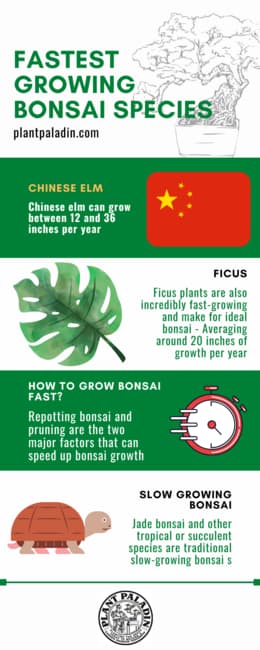
How much does a bonsai tree grow in one year?
Bonsai trees grow between 2 to 36 inches per year depending on the species. Slow-growing bonsai such as Jade will grow 2 to 5 inches per year. Moderate growing species like Juniper will grow 5 to 12 inches per year and fast-growing species like Chinese Elm will grow 12 to 36 inches per year.
Fastest growing bonsai tree species
The fastest-growing bonsai tree species that are commonly available to buy are:
- Chinese Elm
- Japanese Elm
- Maple
- Ficus
- White Eastern Pine
- Austrian Pine
- Canary Island Pine
These bonsai will grow between 12 to 36 inches per year.
Moderate growing bonsai trees
Bonsai trees that grow at a medium speed per year – between 5 and 12 inches include:
- Juniper
- Cotoneaster
Slow growing bonsai trees
Bonsai trees that grow at a slow speed per year – between 2 to 5 inches include:
- Jade
- Fukien Tea
- Wisteria
- Azalea
Wil bonsai trees grow big if not stopped?
Bonsai trees will grow big if they are not pruned or maintained regularly by bonsai owners. Bonsai if left unpruned will grow between 1 and 36 inches per year. Like all plants, should bonsai be given enough light, fertilizer, and soil, they will grow unchecked.
What is the biggest bonsai tree in the world?
The largest bonsai trees in the world are Imperial bonsai trees that can grow as big as two meters or 60 to 80 inches (152 to 203cm). Despite not falling into a bonsai size classification some bonsai have been witnessed to be larger than 2 meters.
Bonsai tree size classification
To fully understand how big bonsai trees can get – you have to understand bonsai size classification. Now I’ve written an entire post talking about this here – which a lot of this information has been taken from.
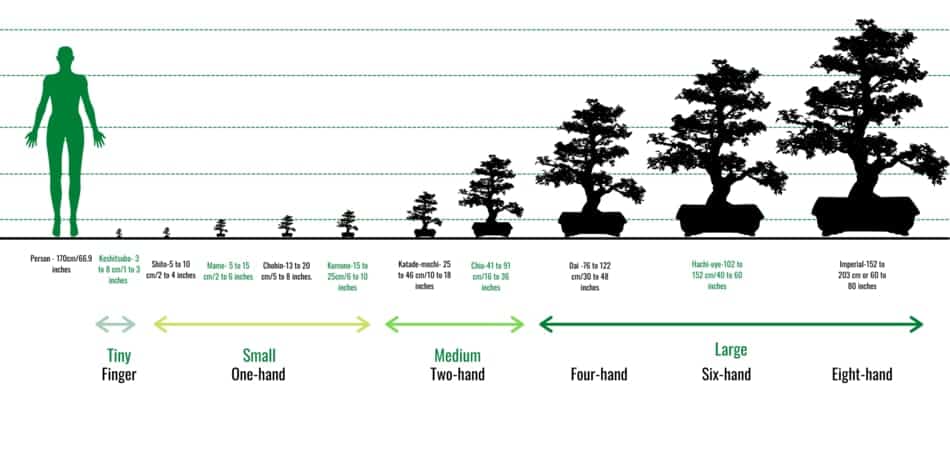
To summarize, bonsai size classification is an easy way for bonsai owners use to determine the category their bonsai fall into.
This is also useful if you are thinking about competing in a bonsai competition which will also use these size classifications as a guide.
These are broken down into the following categories:
Keshitsubo, Shito, Mame, Chohin, Kumono, Katade-mochi, Chiu or Chumono, Dai or Omono, Hachi-uye, and Imperial are the different size classifications bonsai trees come in. Keshitsubo is the smallest at 1 to 3 inches (3 to 8cm) with Imperial the largest at 60 to 80 inches (152 to 203cm).
What are bonsai size classifications?
Bonsai size classifications are a classification system used to indicate the size of a bonsai tree. This is either done through a hand size classification determining how many hands are used to move a bonsai, or through traditional Japanese words such as Keshitsubo or Mame.
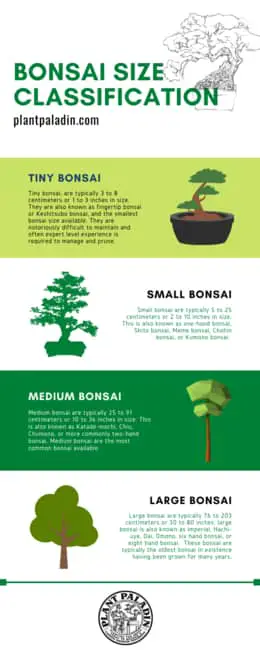
Bonsai tree size classification explained
Bonsai tree size classification is usually broken down by a Japanese name or the number of hands needed to lift the bonsai.
This includes:
- Keshitsubo – a fingertip bonsai that is 3 to 8 centimeters or 1 to 3 inches in size
- Shito – a one-handed bonsai that is 5 to 10 centimeters or 2 to 4 inches
- Mame – a one-handed bonsai that is 5 to 15 centimeters or 2 to 6 inches
- Chohin – a one-handed bonsai that is 13 to 20 centimeters or 5 to 8 inches
- Kumono – a one-handed bonsai that is 15 to 25 centimeters or 6 to 10 inches
- Katade-mochi – a two-handed bonsai that is 25 to 46 centimeters or 10 to 18 inches
- Chiu or Chumono – a two-handed bonsai that is 41 to 91 centimeters or 16 to 36 inches
- Dai or Omono – a four-handed bonsai that is 76 to 122 centimeters or 30 to 48 inches
- Hachi-uye – a six-handed bonsai that is 102 to 152 centimeters or 40 to 60 inches
- Imperial – an eight-handed bonsai that is 152 to 203 centimeters or 60 to 80 inches
Why do bonsai trees use hand measurements?
Hand measurements are used in bonsai to determine how many hands are needed to move a tree. Hand measurements for bonsai were first used hundreds of years ago in Asia as a shorthand to communicate the size of a tree without measuring them.
The different hand classifications are as follows:
Fingertip – Tiny bonsai that are three to eight centimeters or one to three inches in size. also known as Keshitsubo.
One-hand – Small bonsai that are 5 to 25 centimeters or 2 to 10 inches in size.
Two-hand – Medium bonsai that are most common amongst bonsai owners. They are 25 to 91 centimeters or 10 to 36 inches.
four-hand – Large bonsai that are 76 to 122 centimeters or 30 to 48 inches.
Six-hand – Large bonsai that are 102 to 152 centimeters or 40 to 60 inches.
Eight-hand – Large bonsai that are 152 to 203 centimeters or 60 to 80 inches.
Keshitsubo bonsai size classification
Keshitsubo bonsai size classification is for bonsai trees that are three to eight centimeters or one to three inches in size. It is the smallest bonsai size available and is also known as fingertip bonsai.
Shito bonsai size classification
Shito bonsai size classification is for bonsai trees that are five to ten centimeters or two to four inches. It is the second smallest bonsai size available and falls into the one-hand bonsai category.
Mame bonsai size classification
Mame bonsai size classification is for bonsai trees that are 5 to 15 centimeters or 2 to 6 inches. It is the third smallest bonsai size available and falls into the one-hand bonsai category.
Chohin bonsai size classification
Chohin bonsai size classification is for bonsai trees that are 13 to 20 centimeters or 5 to 8 inches. It is the fourth-smallest bonsai size available and falls into the one-hand bonsai category.
Kumono bonsai size classification
Kumono bonsai size classification is for bonsai trees that are 15 to 25 centimeters or 6 to 10 inches. It is the largest small bonsai size available and falls into the one-hand bonsai category.
Katade-mochi bonsai size classification
Katade-mochi bonsai size classification is for bonsai trees that are 25 to 46 centimeters or 10 to 18 inches. It is the smallest bonsai that falls into the two-hand bonsai category.
Chiu or Chumono bonsai size classification
Chiu, also known as Chumono, bonsai size classification is for bonsai trees that are 41 to 91 centimeters or 16 to 36 inches. It is the largest-sized bonsai that falls into the two-hand bonsai category.
Dai or Omono bonsai size classification
Dai or Omono bonsai size classification is for bonsai trees that are 76 to 122 centimeters or 30 to 48 inches. It falls into the four-hand bonsai category.
Hachi-uye bonsai size classification
Hachi-uye bonsai size classification is for bonsai trees that are 102 to 152 centimeters or 40 to 60 inches. It falls into the six-hand bonsai category.
Imperial bonsai size classification
Imperial bonsai size classification is for bonsai trees that are 152 to 203 centimeters or 60 to 80 inches. It falls into the eight-hand bonsai category. It is the largest bonsai size available and was popularised in the past by emperors of Japan.
How big do miniature bonsai get?
Miniature bonsai are three to eight centimeters or one to three inches in size. This falls under the fingertip category and is commonly known as Keshitsubo in most size classifications.
How big do small bonsai get?
Small bonsai are typically 5 to 25 centimeters or 2 to 10 inches in size. This is also known as one-hand bonsai, Shito bonsai, Mame bonsai, Chohin bonsai, or Kumono bonsai.
How big do medium-sized bonsai get?
Medium bonsai are typically 25 to 91 centimeters or 10 to 36 inches in size. This is also known as Katade-mochi, Chiu, Chumono, or more commonly two-hand bonsai. Medium bonsai are the most common bonsai available.
How to keep bonsai small?
A lot of you reading this post will be doing so to see how to avoid growing a bonsai so big.
To keep your bonsai the same size, regular pruning should occur to keep the leaves, branches, and roots of your tree trimmed. A regular schedule should be set up to avoid any unnecessary growth and bonsai owners should opt for slow-growing species such as jade.
How to care for a big bonsai?
The rarity of larger imperial-sized bonsai means that they need to care for in a specific way.
This includes:
Regularly checking for pest infestations
Larger bonsai have more leaves, more branches, and overall more room for insects to hide in.
It’s important that you regularly spray your larger bonsai with neem oil or insecticide, especially during the spring and summer months when insect infestations are ripe.
Keep your bonsai outdoors
Due to the size of these bonsai, there is just no chance that you will be able to meet the bonsai light needs or soil needs by keeping them indoors.
As such, keeping your bonsai outdoors even during the winter months is the best option to maintain the health of your bonsai.
Keeping bonsai this large in pots may also prove to be challenging so you might want to opt for keeping big bonsai planted in the ground.
Specialist hoses
If you live in a wet climate then you might get by not watering your bonsai.
For the rest of us, watering a bonsai tree this big just won’t work with a regular watering can.
Instead, you need to invest in a water hose with a nozzle (link takes you to Amazon). Then step on a ladder and water from the leaves to the root of the plant.
Specialist equipment
Due to the size and strength of your bonsai tree, it is unlikely that the bonsai shears or root cutters that you use on medium or small-sized bonsai will work on the larger imperial-sized bonsai.
Instead, then you might need to opt for hedge trimming shears or other specialist tools.
How to care for a miniature bonsai?
Miniature bonsai, because of their size, are arguably the hardest size bonsai to care for.
Due to these bonsai only being around an inch big, you often will require special tools such as magnifying glasses or specialist trimmers to maintain the size of your bonsai.
These miniature bonsai also have a habit of drying out quite easily so it’s important you invest is a soil mix that is good at holding onto moisture or consider using sphagnum moss or other types of mosses to help.
The key takeaways then would be:
- Check at least twice per day to see if it need water
- Use a soil that is good at retaining moisture
- Succulent species work best for miniature bonsai so consider investing in those.
- Ensure the plant species you opt for are slow-growing such as jade to avoid you having to do too much upkeep
These bonsai due to their size can, however, be kept indoors so work well for apartment living.
How to care for a small bonsai
Small bonsai (between 5 and 25cm) are relatively easy to care for and as such are some of the most common types of bonsai housed by garden centers.
A few key takeaways to maintain these then would be as follows:
- This plant can be kept either indoors or outdoors. Consider moving outdoors during the summer and indoors during the winter.
- Check twice per day for water.
- Beginner-friendly species include Chinese elms and junipers
- Ensure your bonsai gets enough light, the biggest problem with small bonsai is a lack of light so keep it near the windows or outdoors if possible.
How to care for a medium bonsai
Medium-sized bonsai (between 25 to 91 CM) is the most common bonsai species out there and will be what most of you have.
As such the wealth of information on caring for these plants is massive.
A lot of the steps then will be the same as caring for small-sized bonsai such as:
- This plant can be kept either indoors or outdoors. Consider moving outdoors during the summer and indoors during the winter.
- Check once per day for water.
- Beginner-friendly species include Chinese elms and junipers
- Ensure your bonsai gets enough light, the biggest problem with small bonsai is a lack of light so keep it near the windows or outdoors if possible.
- Check regularly for pests, medium-sized bonsai will have more leaves, meaning a higher chance for insect infestation.
What is the most common size for a bonsai?
The most common size for a bonsai is 25 to 91 centimeters or 10 to 36 inches. Most bonsai in garden centers are sold at this size. These fall into the Katade-mochi, Chiu, Chumono categories. They are also commonly referred to as two-hand bonsai.
How big is your bonsai?
Now I didn’t just want this to be all about what I had heard so I called up a few of the professionals.
First I visited my local botanical gardens and asked them the size of their bonsai trees and the average size bonsai trees get. Here was their answer
“ Our bonsai collection is typically around a meter each, some of the larger trees we have though can be a little tricky to keep which is why we aim to maintain them around a meter”
I also called up Heron’s Bonsai asking them about the most common size trees that they stock and here was their answer:
“30 to 70cm are the averages sizes we sell to beginners”
Finally, I surveyed 20 plant paladin readers to find out how big your bonsai is, here were the results:
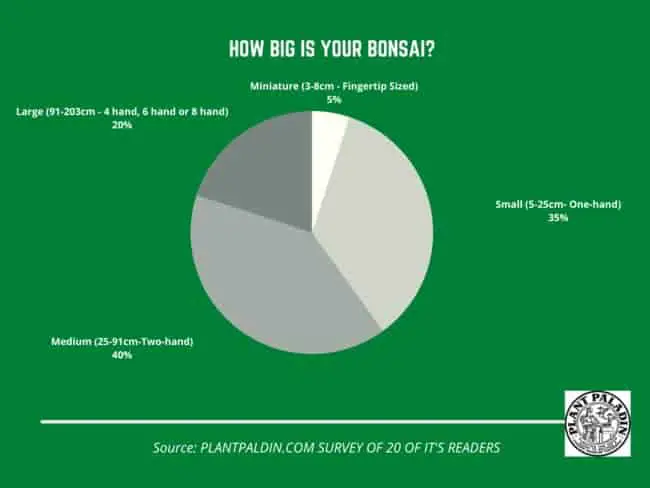
My top picks for the gear you will need!
So like I mentioned earlier, over the past three years of running PlantPaladin, hundreds of people have asked me for my recommendations on the best bonsai gear on the market.
Having spent thousands of dollars on bonsai items these past few years and tested at least 100 bonsai-specific products, I’ve listed my favorite products below – All of which I highly recommend and think you can get great value.
They can purchase directly by clicking the link to take them to Amazon.
Bonsai Tool Set: One of the significant challenges I’ve had is finding a toolset that was not only durable but didn’t break the bank. SOLIGT has recently developed a fantastic bonsai tool set that covers all the tools you need to trim, prune, and repot your trees. – You can grab it here.
Complete Bonsai Set: Many of you will want to grow your bonsai trees entirely from scratch, but finding the varicose seeds, pots, and other items in one place can be challenging. Leaves and Sole then have created a complete bonsai set that I’ve personally used that ticks all the boxes. You can grab it here.
Bonsai wire: The number of times I’ve run out of wire for my bonsai or purchased cheap bonsai wire that doesn’t do the job is embarrassing for me to admit. After a lot of trial and error, I found that using Hotop’s aluminum bonsai wire is one of the best options on the market. This can easily be used for both indoor and outdoor bonsai. You can grab it here.
This post was written by Fehed Nicass who has been passionate about bonsai for over 2 years.

